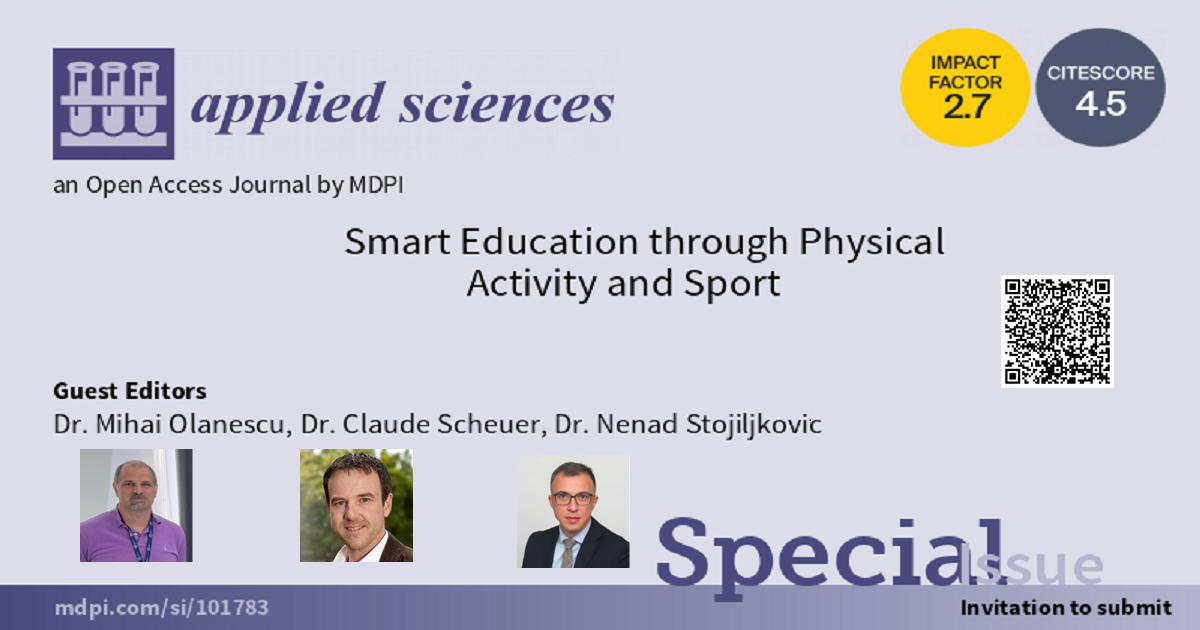- 2.5Impact Factor
- 5.5CiteScore
- 20 daysTime to First Decision
Smart Education through Physical Activity and Sport
Special Issue Information
Dear Colleagues,
This Special Issue is devoted to the enhancement of practicing physical activities and sports among students using a variety of smart, innovative approaches. In this Special Issue, we invite submissions exploring new methodologies and ideas regarding the teaching of physical education and motivation of students to practice sports. We encourage articles covering high-impact research results in the field of PE, PA and sports, such as: strategies to enhance sport and exercise participation, sports engineering, trending technologies in sports, motivation in sports, etc. Sedentarism among students is sadly a very common problem and that is mostly caused by a lack of motivation and risk of injuries. Finding innovative approaches in this area will help to improve students’ participation in physical activities, reducing obesity and other health issues.
Both theoretical and experimental studies are welcome, as well as comprehensive review and survey articles.
Topics of interest for this Special Issue include, but are not limited to:
- Health, physical activity and sport for students;
- Sport, exercise and physical activity for all;
- Formal and nonformal motor activities;
- Fitness and leisure activities;
- Motivation in sports, physical education and physical activity;
- Strategies to encourage sport and exercise participation;
- Barriers to sports and physical activity;
- Students' sports performance;
- Sport engineering;
- Trending technologies in sport;
- Monitoring sport and physical activity—measurement and evaluation;
- Motor learning and control;
- Computer vision in sport;
Dr. Mihai Olanescu
Dr. Claude Scheuer
Dr. Nenad Stojiljkovic
Guest Editors
Manuscript Submission Information
Manuscripts should be submitted online at www.mdpi.com by registering and logging in to this website. Once you are registered, click here to go to the submission form. Manuscripts can be submitted until the deadline. All submissions that pass pre-check are peer-reviewed. Accepted papers will be published continuously in the journal (as soon as accepted) and will be listed together on the special issue website. Research articles, review articles as well as short communications are invited. For planned papers, a title and short abstract (about 100 words) can be sent to the Editorial Office for announcement on this website.
Submitted manuscripts should not have been published previously, nor be under consideration for publication elsewhere (except conference proceedings papers). All manuscripts are thoroughly refereed through a single-blind peer-review process. A guide for authors and other relevant information for submission of manuscripts is available on the Instructions for Authors page. Applied Sciences is an international peer-reviewed open access semimonthly journal published by MDPI.
Please visit the Instructions for Authors page before submitting a manuscript. The Article Processing Charge (APC) for publication in this open access journal is 2400 CHF (Swiss Francs). Submitted papers should be well formatted and use good English. Authors may use MDPI's English editing service prior to publication or during author revisions.

Benefits of Publishing in a Special Issue
- Ease of navigation: Grouping papers by topic helps scholars navigate broad scope journals more efficiently.
- Greater discoverability: Special Issues support the reach and impact of scientific research. Articles in Special Issues are more discoverable and cited more frequently.
- Expansion of research network: Special Issues facilitate connections among authors, fostering scientific collaborations.
- External promotion: Articles in Special Issues are often promoted through the journal's social media, increasing their visibility.
- e-Book format: Special Issues with more than 10 articles can be published as dedicated e-books, ensuring wide and rapid dissemination.

